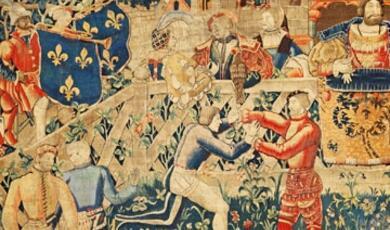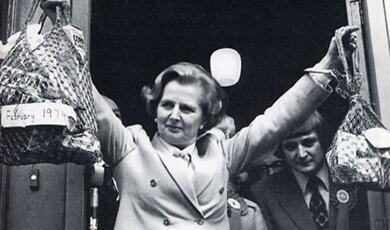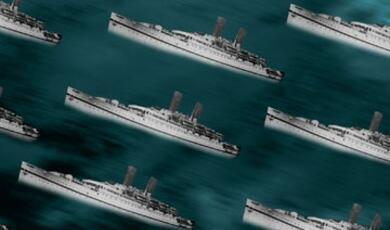In the beginning: the Roman, the Viking and the Norman Conquests
Share
- Details
- Text
- Audio
- Downloads
- Extra Reading
As an island people, the inhabitants of Britain were repeatedly subject to invasions from the Continent, at least until they had a powerful navy of their own. Although most historians consider that the Glorious Revolution of 1688 was also a successful invasion, this time by the Dutch, the earlier three ensured a profound transformation in the political and social organisations of the conquered territory.
Download Text
IN THE BEGINNING:
THE ROMAN, THE VIKING AND THE NORMAN CONQUESTSProfessor Kathleen Burk
In Shakespeare’s ‘Richard II’, John of Gaunt proclaims that England is a ‘precious stone set in the silver sea, which serves it in the office of a wall, or as a moat defensive to a house, against the envy of less happier lands’. This was possibly the case later, when she had a navy, and especially when she had a navy second to none. Without a navy, the sea was, in the Viking term, a whale-path, which might be a road to trade, but equally a road to plunder or invasion. And for the thousand years from 55 B.C. to 1066, Britain was repeatedly raided and invaded. In 55 BC, 54 BC and 43 AD, it was the Romans; from the late 8th century to the early 11th century, it was the Vikings; and in 1066 - as we all know - it was the Normans. This evening I want to give an overview of British relations with Europe during this period, as the first in my series this year on Anglo-European relations.
The Romans viewed Britannia as backward and barbaric, but this was hardly the case by the first century B.C. Certainly it was beyond the Ocean, for the Romans, used to the non-tidal Mediterranean, something of a psychological barrier, but it had a complex system of tribal societies, which, although pre-literate, had used wheeled vehicles for over a thousand years, coins for two centuries, and occupied organised major centres, the hill-forts. Furthermore, from about 700 B.C., there had been regular trade with the Continent. Nevertheless, the Britons were lesser breeds without the law: Julius Caesar described them as savages who painted themselves blue with woad, and it was Caesar who first embarked on an invasion of Britain. Why?
The reasons do not seem to me to be very complex. In 59 B.C., Caesar was one of two consuls in Rome. With his term of office coming to an end, what new fields should he conquer? He managed to obtain control of a large territory, which included Cisalpine Gaul (northern Italy ) and Transalpine Gaul (southern Gaul ), the command of four legions and the right to appoint legates and found colonies; his immediate task was to prevent the migration of the Helvetii from what is now Switzerland. By 56 B.C., he had conquered all of Gaul, and turned his gaze towards Britain. His public reason for launching an invasion was for fear that the Britons would help the newly-conquered Gauls to rise up against the Romans. He may have had the Veneti in mind. A tribe in north-west Gaul, they had had the largest fleet of ships in Gaul, and used regularly to trade with the Britons; Caesar, however, had brutally crushed the Veneti and destroyed their fleet. More to the point, however, he needed dramatic new conquests to shore up his prestige in Rome, and booty for his soldiers in order to retain their loyalty, since he would need their support in his future grab for supreme power in Rome. He probably had no firm political plans for Britannia, other than to force the tribes’ submission.
Caesar made two attempts at conquest. Late in the summer of 55 B.C., some one hundred ships sailed from Gaul, carrying only two legions and some auxiliary troops, hardly ten thousand men; the ships carrying the cavalry were prevented by adverse winds from landing at all. When Caesar came within sight of the coast, he saw British sentries posted on the cliff tops; there were problems disembarking because of the British defence, and the Romans could not pursue the Britons because they lacked cavalry. Part of the Seventh Legion were wiped out whilst foraging for food, whilst four days later, many of his ships were damaged or wrecked by storms. He managed to defeat a British force, and he carried back some hostages to Gaul, but limping back, as it were, before winter set in was not the stuff of sagas.
The following year, he came better prepared. This time, there were five legions of fighting men, who sailed to Britain in over 800 ships; this time, a properly defended beachhead was constructed, to protect their disembarkation. The British were brought to fight a pitched battle, which they lost; their leader, with his 4,000 chariots, retreated northwards with his force in disarray. A rival of this particular British leader offered his support; the first leader’s stronghold was stormed; and there was then a final battle, probably in Kent. Taking hostages, Caesar returned to Gaul, where there was a grave threat of a Gallic uprising. Thereafter, Britain was seen in Rome as within the Roman sphere, although it was not an official province. It was not until eighty years later, during the reign of Caligula, that the decision was taken to annex Britain, and in 40 AD an army was assembled at the Channel. However, at the last moment, Caligula ordered his army to pick up sea shells instead: the re-conquest of Britain would have to wait, although not for long.
In 41 AD, Caligula was assassinated in a plot led by senators and army officers, who planned the restoration of the Republic. However, Caligula had an uncle, Claudius, whom ancient sources depict as deformed and half-witted, and irrelevant to any struggle over power. He was also, it must be added, portrayed as a formidable scholar, a writer on the Etruscans. On the night of the coup, he was discovered by a soldier of the Praetorian Guard in the Imperial Palace, hiding in fear behind a curtain. The only surviving member of the family of Augustus, Claudius was promptly proclaimed emperor and protected by the Guard in their camp. Negotiations during the night confirmed their support. Inadvertently, therefore, there ascended to the throne a man of impressive intellect and qualities of leadership. He was also a man of some tenacity, surviving an attempted coup the following year. He needed to make his mark by conquest and he needed the booty to keep the army happy. (An army would loot, but it would be controlled looting, with each soldier entitled to a specific proportion of the total amount.) Claudius also needed to provide the army with a challenging - and external - target, thereby lessening the danger that they might turn on him. A Britain in political turmoil was just the thing - and thanks to Caligula, the plans for an invasion were already in place.
The Claudian invasion of AD 43 was of a different order entirely from the two earlier attempts in the previous century, because the plan from the first seems to have been first to conquer Britannia and then to organise it into a province. Certainly the invasion itself was well-planned, and led by a distinguished soldier and governor of a Danubian province, Aulus Plautius. He led an army of four legions and their auxiliary troops, 40,000 in all, with 20,000 of them drawn from forces stationed on the Rhine. They were disciplined, experienced and tough. The force was divided into three, to facilitate the landing of so many men, but there is some disagreement as to where the landings took place. The British leaders were defeated at a major battle at a river crossing, possibly the Medway, and in a skirmish on the Thames soon thereafter, one of the two British leaders was killed. Word was then sent back to Claudius to come to Britain to preside over ‘his’ victory. He spent just sixteen days in Britain, but they were memorable. He brought elephants with him to terrify the enemy, and was present at the fall of Camulodunon, today Colchester, which was regarded by the Romans as the British capital. He then received the surrender of eleven British kings. News of the defeat would have travelled fast, and many other British leaders deemed it the better part of valour to submit, at least for the time being.
A province was set up, with the capital at the now- Latinised Camulodunum, and then the army split into three, with detachments marching north, north-west, and west. The western army was commanded by Vespasian, who in AD 69 would become emperor. His force fought thirty battles, took the Isle of Wight, and subdued two powerful tribes, the Durotriges in Dorset and the Dobunni of Gloucestershire/Somerset. Maiden Castle in Dorset was one of his targets. There was a war cemetery there, in which one of the skeletons still had embedded in his spine a bolt from a ballista, a machine like a cross-bow, which was used by the legions as artillery. (This skeleton can be seen in Dorchester Museum.) Vespasian subdued the south-west, whilst the other two armies worked their way northwards, conquering tribes and setting up client kingdoms. Rome also used a weapon unmatched by any other people, and this was engineering. The conquest was accompanied by the building of forts and military roads, and, eventually, by Hadrian’s Wall, largely built during the period AD 122 to 127, and extending 76 Roman miles or 113 km long, from South Shields to Bowness, with a small fort every mile and larger forts every seven miles or so.
There were, of course, native uprisings, two of which have some fame. An early one was that of Caractatus, son of one of the leaders of the defence against the invasion. He retreated to Wales, where he encouraged the Silures and the Ordovices to resist. Charismatic leader though he was, the experienced and highly trained Roman army defeated Caractatus in AD 49, and he had to abandon his family and flee. He made his way to the territory of the Brigantes, but Cartimandua the Queen, in alliance with the Romans, promptly turned Caractatus over to them. He and his family were taken to Rome, where he was paraded as a captured enemy, but one of honour and great military distinction. He was brought to the Senate, where he made a speech, reportedly asking, ‘Why, with all these great possessions, do you still covet our poor huts?’ The Emperor Claudius, impressed by his words and his dignified bearing, pardoned him.
The other rising about which every schoolgirl used to know was that led by Boudicca, Queen of the Iceni of East Anglia, in AD 60-61. Her husband Prasutagus died in 60, leaving half of his kingdom to the emperor, Nero, a time-honoured way of ensuring that the local Romans did not take all of his estate. Nevertheless, on his death, Roman officials moved into the kingdom and evicted the nobles from their lands, plundered the king’s household, flogged the king’s widow, and raped his two daughters. Boudicca led the Iceni, who were joined by the Trinovantes of Essex, as they sacked Colchester, Verulamium (now St Albans ), and London, and wiped out part of the Ninth Legion. According to the Roman historian Tacitus, ‘The British did not take or sell prisoners, or practise other war-time exchanges. They could not wait to cut throats, hang, burn, and crucify - as though avenging, in advance, the retribution that was on its way.’ This came at the hands of the Roman governor, Suetonius Paullinus, whose forces met those of Boudicca somewhere in the East Midlands, where, again according to Tacitus, 80,000 British men and women were killed, at the cost of 400 Romans. Boudicca committed suicide by taking poison, and Paulinus went on a rampage of destruction, before he was quietly re-called to Rome.
My subject this evening is invasions, and I must therefore leave the Romans to extend and pacify their new province. We now enter a period of strong historigraphical uncertainty. Whilst reading some recent publications to prepare for this lecture, I discovered that what I had learned as an undergraduate about the coming of the Anglo-Saxons was wrong, wrong, wrong. We had been taught that this was the Age of Migrations, when Angles from the angle of land between the Weser and the Elbe, Saxons from land closer to the North Sea, and Jutes from Jutland had travelled in their thousands and generally drove the native British from their homes in the east and centre of Britain into the west, and particularly into Wales. Not all were emigrants: many were pirates and plunderers. But whatever they were, they were responsible, I had learned, for the disappearance of what was left of both Iron Age and Roman Britain, save for some burials and a few place names. I now find that very few archaeologists and historians believe this any longer. What made writing this lecture even more difficult than I had anticipated, however, is that the evidence is so ambiguous that there is no agreed story to put in its place. There are proud defiant archaeologists who will believe only what emerges from the earth, scorning what written evidence may be available; conversely, there are historians who believe that written evidence can be used in a careful manner so that it complements the archaeological evidence.
In AD 360 and again in 364, there were significant plundering raids in the north by the Picts from eastern Scotland and the Scots from Ireland. [Sellar and Yeatman explain their origins in 1066 and All That: ‘IMPORTANT NOTE: The Scots (originally Irish, but now Scotch) were at this time inhabiting Ireland, having driven the Irish (Picts) out of Scotland ; while the Picts (originally Scots) were now Irish (living in brackets) andvice versa. It is essential to keep these distinctions clearly in mind (andverce visa).] But it was 367 which saw the most frightening of the 4th century barbarian incursions that termed the ‘barbarian conspiracy’. These involved the Picts, the Scots, and the Attacotti, a people unknown but probably from the north. At the same time, the Saxons attacked Gaul. Opinion is divided as to whether this was indeed co-ordinated, or just coincidental: the Romans certainly thought the first, while predominant, although not unanimous, opinion now is that it was coincidental. In any case, Hadrian’s Wall was overrun, and the commander of the Saxon shore forts was killed. Crack troops were dispatched to Britain. Whilst there was military success in the fighting around London, with most of the barbarian bands destroyed, there was a crisis in the army itself: there was serious desertion by garrison forces, those who were already stationed in Britain, and they took part in the looting and banditry. At the same time, political exiles in Britain tried to lead a revolt. Order was eventually restored, but this seems to have been a turning point for Britannia as a Roman province.
There were continuing raids by the Picts and by Irish pirates, at the same time as there was political and military turmoil in the governing of the empire. Three times emperors were proclaimed in Britain, and each time soldiers were withdrawn, as the candidates crossed the Channel to fight for their aspirations. The withdrawal of the legions meant that a significant element in the British economy went with them: for one thing, there were fewer buyers for agricultural surpluses, and this had a rapid knock-on effect first on the rural economy and then on the urban centres who depended on their custom. But it was apparently the weather of AD 406 which provoked the end of Roman rule in Britain. In December the river Rhine froze over, enabling various tribes, including the Vandals, to cross over the military frontier of the empire and into Gaul. Constantine, the commander in Britain, feared the loss of the coast across the Channel, as the consequence would be that Britain was cut off from the empire; therefore, he crossed over to Gaul with his troops to combat the flood of migrants, although with very little success. As it happened, he soon found himself at war with the emperor, Honorius, and Constantine ’s defeat left Britain without any imperial government. In 410, there was another barbarian attack on Britain, and when Britons sent word to the emperor to ask for help, his response was that they had to look to their own resources.
As a result, native leaders came forward to take command in the fight against the barbarians, and with success. As a further result, having shown themselves that they could stand on their own, without imperial support, they refused to re-join the empire. The decision was probably made easier by the fact that this released Britons from the imperial taxation system, a heavy burden, and from interference by the representatives of the centre in local affairs. One result was the throwing up of a number of local rulers, who seemed to have formed a confederation which by 425 was under the leadership of a high king called Vortigern. The claim by a 6th-century historian was that it was Vortigen who brought in Saxon mercenaries under the leadership of the brothers Hengist and Horsa. It is problematic, to say the least, whether they really existed - after all, their names mean ‘horse’ and ‘mare’. One explanation is that Saxon mercenaries were invited in to fight the Picts; not receiving their due pay, they revolted and brought in others from their homelands to help in the fight. They carved out their own territories, and the fragmentation of Britain began again. But it is probably not the case that Britain was subject to massive invasions and migrations by Angles, Saxons and Jutes. Obviously they came, but they could have come as traders and small tribal groups. There appears to be no archaeological evidence for slaughter and destruction, nor for the fleeing of thousands to Wales. In this case, the jury is out, but the answer will probably be that rural Britain evolved into, rather than was driven into, a changing set of Anglo-Saxon statelets.
What is incontrovertible is that there were repeated and destructive Viking invasions. The first took place in 789: a group of three ships arrived in Dorset, and the reeve of Portland, assuming that they were traders, went out to greet them. Possibly to his brief surprise, they killed him, and then attacked the town. There were further raids in 792. In 793 there took place one of the most famous of all raids, that on the monastery at Lindisfarne. As you can see, given the very shallow keel, it was easy to draw the boats up on such flat and sandy beaches. This is how the Anglo-Saxon Chronicle described it: ‘In this year dire portents appeared over Northumbria and sorely frightened the people. They consisted of immense whirlwinds and flashes of lightening, and fiery dragons were seen flying in the air. A great famine immediately followed these signs, and shortly after that in the same year, on 8 June, the ravages of the heathen men miserably destroyed God’s church on Lindisfarne, with plunder and slaughter.’
Over the following fifty years, the raids continued, but the rate of attacks changed dramatically in the 840s: there were lots of raids on the east coast in 841, and in 850 and 854 a Danish army actually wintered in eastern England. However, a Kentish force defeated the Danes off Sandwich in 851 in the first recorded naval battle in English history. Furthermore, in 851, King Aethelweld of the West Saxons, the father of Alfred the Great, defeated a large Danish army which had attacked Canterbury and London. The final decades of the ninth century saw the Viking threat grow ever more dangerous, with their growing ability to move from one side of the Channel to the other to take advantage of whatever opportunities arose, and with the emergence of ever larger Viking armies.
The hero of this story - at least for the non-Vikings - is King Alfred the Great of Wessex. By 874, the Vikings controlled both Northumbria and Mercia, and a Viking army decided to move into Wessex. In 878, they had forced most of Wessex to submit to them. The Anglo-Saxon Chronicle tells how Alfred and a few of his men held out against the Danes, hiding in woods and fens, and it is this period of danger and discretion which produced a fable which has lasted for centuries, that of Alfred and the cakes. As it was related in the Annals of St Neots, ’One day a certain peasant woman, wife of a cowherd, was making loaves, and the king was sitting by the fire tending his bows and arrows, and other weapons. But when the poor woman saw that the loaves she had put over the fire were burning she ran up and took them off, scolding the invincible king and saying, “Look there man, you can see the loaves are burning and you’ve not turned them, though I’m sure you’d be the first to eat them nicely done!” The miserable woman little thought that this was King Alfred who had fought so many wars against the pagans and won so many victories.’
Alfred and his men eventually emerged from their stronghold in the marshes at Athelney in Somerset to rally the forces of Somerset, Wiltshire and parts of Hampshire, and they soundly defeated the Danes under their leader Guthrum at the battle of Edington. By the treaty with the Danes, the Danes were confined to certain areas, and the Danish army retreated to East Anglia and ‘shared out the land’ - that is, took it over to farm themselves. At the same time, part of the Viking army went over to Francia to see what they could find there, and Alfred, who had been King since 871, had twelve years of peace to consolidate his position and prepare his defences for future onslaughts. By this time, Wessex was the final target, partly for geographical reasons, and partly because the Danes had been extending their control over their newly-won territories. He made some attempts to build a navy, with mixed results; much more successful was his system of establishing fortresses or fortified burghs, along with a system of raising manpower fairly to garrison them and a system of taxation to support them. His success was a tribute to his organisational skill, and to the power he could exercise to organise his kingdom into a unique defensive force with the ability to exploit its manpower. The result was a kingdom covered with a system of garrisoned forts, spaced so that no settlement would be more than thirty miles from one. These garrisons could defend the localities, but they could also harass any invading Danes. The system required 27,070 men just to provide these garrisons, and Alfred could put a similar-sized army into the field - together they constituted one of the largest of the early mediaeval armies.
The changes in British political geographical over Alfred’s lifetime were dramatic. When he was born in 849, there were a number of English kingdoms, from Edinburgh south to the Channel; there were a number of British kingdoms to the West, from Strathclyde to Cornwall ; and there were the kingdoms of the Picts and the Scots in the north and north-west. At his death in 899, just fifty years later, the independent English kingdoms were restricted to Wessex, western Mercia and the northern part of Northumbria, the area of Bernicia/Lothian; the rest of England and much of the former territory of the Picts was controlled by the Vikings. At a number of points in the Anglo-Saxon Chronicle, it is noted that the Vikings took part in a ‘sharing out of land’ in Northumberland, Mercia and East Anglia, and the presumption is that at that point, the conquerors moved from being landless warriors to becoming landed gentry.
The next forty years saw the expansion of Wessex until in 937, Æthelstan is referred to as ‘King of the English, raised to the throne of the kingdom of Britain by the right hand of the Almighty’ and, in a private document, as ‘most glorious king of the Anglo-Saxons and Danes’. There were some years of peace until 980, when, during the reign of Æthelred II the Ill-Counseled, the Danes sacked Southampton and ravaged both Thanet and Cheshire. These were no longer small-scale raids: now they were large expeditions with royal leaders. Ethelred appeased them by paying large sums of money, as being cheaper than paying to raise an army, and they soon learned that extorting money was easier and more profitable than episodic booty-grabbing. This was the Danegeld, and its amount soon rose from 4,500 kgs of silver in 991 to 22,000 kgs in 1012. The taxation system that could provide such sums was advanced compared to anywhere else in Europe, and the fact that England was wealthy enough to supply the silver demonstrated the wealth of the country, which was probably based primarily on the production of wool.
The Danish leader Swein Forkbeard then decided to conquer England, which he did in a rapid campaign in 1013, which forced Æthelred and his family into exile in Normandy - his wife Emma was the daughter of the count Richard of Normandy. Swein died the following year, and his son Cnut was chosen king by the Danish fleet, although it took him two years to establish his rule against Æthelred. Æthelred and his son Edmund Ironside both died in 1016; a few days after the death of Edmund, Cnut was the unopposed King of the English. He married Emma, Æthelred’s widow. Cnut returned to Scandinavia often to deal with the opposition to his rule there, and by 1027, he was ‘king of the whole of England and Denmark and Norway and parts of Sweden ’. He was the last great Viking.
As you will have noticed, we are rapidly reaching the climax of this period. The crux of the coming crisis was one of the sons of Queen Emma, Edward the Confessor. The fact that she was also the great-aunt of Duke William of Normandy could perhaps be enough to charge her with indirect responsibility for the Norman Conquest. Edward the Confessor was childless. Because of his parentage, and because of his long years of exile in Normandy, he favoured Normans, a number of whom he brought over to England to fill the offices of state and the Church. In this sense, it is not implausible that he favoured Duke William, his closest male relative, as his successor.
There was, of course, another candidate, and this was Earl Harold Godwinson. Harold’s father, Godwin, was also the father of Edward the Confessor’s wife, Queen Edith, and the father of a number of strong sons: Tostig, Earl of Northumbria, Gyrth, Earl of East Anglia, Leofwine, Earl of Kent, and Harold, Earl of Wessex - all of whom were to die in 1066. By 1052, it has been said, Godwin and his sons were defining themselves by opposition to the Normans brought over by Edward. I do not think that it is necessary to go into too much detail about the Conquest: it is, after all, possibly the most familiar event in British history - although I suppose that the Second World War also has a claim here.
On 5 January 1066, Edward the Confessor died, but before doing so, he designated Harold Godwinson as his successor. Harold was crowned the following day. Now: this angered two other men, each of whom considered that he had a valid claim to the throne. One was Harald Hardrada, or Harold the Ruthless, 6’7” tall, delighting in war, and the King of Norway: his claim was pretty feeble, and his ascension to the throne would always have depended on conquest. The other was William, Duke of Normandy. He had two claims: one was through his relationship to Edward himself, and the other was his claim that Edward had promised him the throne of England. William also claimed to feel betrayed by Harold himself, who had, he insisted, sworn on holy relics to support William as king. Both Harald Hardrada and William prepared for war, and Harold of England prepared his defences.
Harold’s brother Tostig had been thrown out of his earldom by men who had been angered at his levying a heavy tax and by the assassination of a popular thegn, and had replaced him with Morcar, brother of Edwin, Earl of Mercia; Tostig’s brother Harold did not support his bid to return. Tostig, therefore, decided to back the King of Norway, in the hope of regaining his lands; he sailed to Norway and offered his allegiance. Hardrada in August sailed from Norway to Orkney and thence to Yorkshire, with the city of York his objective. As the Norwegians moved in that direction, they were met at Fulford by the troops of Morcar and Edwin, and in the ensuing battle, the brothers were defeated and slain. York surrendered, and after securing supplies, Hardrada moved to Stamford to await the arrival of hostages.
News of the Norwegian invasion probably reached King Harold in mid-September. He immediately began raising a force to meet the Vikings, and men came from far and wide to join him. They left on 16 September and travelled up the Roman road called Ermine Street, later called the Great North Road, and now the A1. On 25 September he met the forces of Tostig and Harald Hardrada at Stamford Bridge, and defeated them; both his brother Tostig and the King of Norway were killed.
Meanwhile, after being trapped in harbour on the Normandy coast for some weeks by adverse winds, William finally set sail for England on 28 September with a fleet of over seven hundred vessels, landing at Pevensey on the 29th. He then moved his troops to Hastings. In early October, Harold learned of the landing of the Normans, and travelled on average 27 miles a day to reach London in seven days, although not all of his forces made it in time for the crucial battle. He remained in London for about a week before marching out to Hastings. On 14 October, the two armies faced each other over 400 yards of marsh and scrubby hillside. At 9 am the Norman archers began to move, and the battle was joined. At 9:30 the Norman cavalry attacked but were repulsed; William’s men fell back, pursued by part of Harold’s army. At 10 am William rallied his army, and at 10:30 the Normans counter-attacked, over-running isolated groups of English with their cavalry. At 11 am the armies re-grouped, and at noon the fighting resumed. The battle wavered back and forth over the afternoon, but the English were weakening, and at 4 pm, William made a final win-or-lose assault: he ordered his archers to fire high, thereby plunging arrows onto the heads of the English. An arrow possibly struck Harold in the eye, after which he was possibly cut down by a Norman soldier - another contentious issue. In any case, he died, and with him died English independence and the English state.
On 25 December 1066, William of Normandy was crowned King of England at Westminster Abbey. The early years of his reign were not quiet ones; indeed, there was widespread unrest. The most important challenge to his rule came, wonderfully, from the Danes. In the summer of 1069, Sweyn Estrithson, the King of Denmark, launched his long-anticipated attack on England. A fleet of 240 ships sailed under the leadership of his two sons - named Cnut and Harold, as it happens - and of his brother Osbern. It brought to England an army of trained warriors, which included many men of high rank in Denmark, but what was particularly seen as a threat was the fact that Swein could count on considerable support within those regions of England which had for centuries had links with Scandinavia, particularly in the North. The ships first appeared off Kent, and then made their way to the safe anchorage of the Humber River. Its arrival was the signal for a general uprising in Yorkshire. The body of rebels marched on York. The Norman garrison were unable to hold the castle, so they marched out and set fire to the city; they then fought to the death, and on 20 September, York fell to the rebels and the Danes. Many of the Danish and English troops marched south and dispersed over the North Lincolnshire countryside, where they were welcomed by the peasantry and entertained by them at village feasts.
The whole Norman Conquest was thus in peril, for the resistence to William was assuming a coherence it had heretofore lacked. A strong Scandinavian force was at large in England, and it was supported by a considerable army led by powerful Saxon magnates. The news spread widely, and there were revolts elsewhere. The Conqueror reacted vigorously. He left Geoffrey, bishop of Coutances, to deal with a rising in Dorset, while he moved towards the North. The Danes retreated back over the Humber into Yorkshire. He then went westward to suppress a rebellion led by the Welsh princes. When he reached Nottingham, William learned that the Danes were preparing to re-occupy York, and he turned northwards. On his way, he savagely devastated the land through which he passed, sparing no male and leaving behind him nothing which could support life. Just before Christmas he reached York, where he celebrated the birth of Christ. He then split up the Norman troops into smaller bands, which began a systematic ‘harrying of the North’. So terrible was it that the results were still apparent in the Domesday Book twenty years later. William pushed on to Chester, and reached it before his enemies were prepared to meet him. The resistence which had so nearly overwhelmed him was finally broken. The Danish army, seeing their English allies defeated, accepted a bribe to depart, and William returned to the South. He faced no further serious threat in England.
The permanence of the Norman Conquest had finally to be accepted. And of course, as we learn from 1066 and All That, ‘The Norman Conquest was a Good Thing, as from this time onwards England stopped being conquered and thus was able to become top nation.’ But that is a topic for another lecture.
© Professor Kathleen Burk, 2005
This event was on Wed, 12 Jan 2005
Support Gresham
Gresham College has offered an outstanding education to the public free of charge for over 400 years. Today, Gresham College plays an important role in fostering a love of learning and a greater understanding of ourselves and the world around us. Your donation will help to widen our reach and to broaden our audience, allowing more people to benefit from a high-quality education from some of the brightest minds.


 Login
Login







